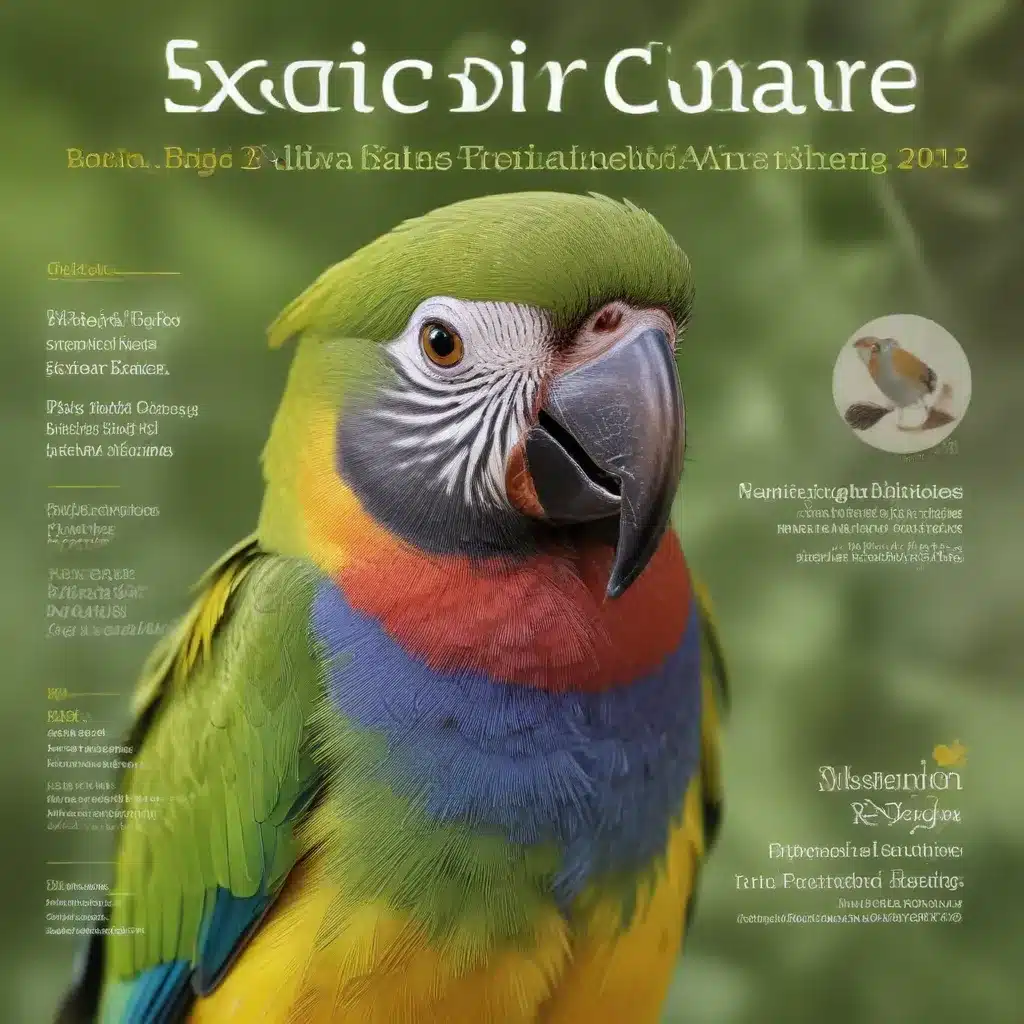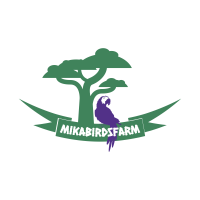
Avian Behavioral Enrichment
Importance of Behavioral Enrichment
Providing appropriate behavioral enrichment is crucial for the well-being of exotic birds in captivity. In the wild, birds engage in a wide range of natural behaviors, from foraging and exploration to social interactions and flight. Replicating these opportunities in a captive environment is essential for promoting physical and psychological health. Without adequate enrichment, birds may develop stress-related behaviors such as feather plucking, excessive vocalizations, or pacing.
Types of Behavioral Enrichment
Enrichment for exotic birds can take many forms, including:
- Foraging Opportunities: Hiding food in puzzle toys, scattered throughout the enclosure, or in natural substrates encourages natural foraging behaviors.
- Sensory Stimulation: Providing varied textures, sounds, and visual elements can engage a bird’s senses and prevent boredom.
- Social Interaction: Allowing birds to interact with their own species or with familiar human caretakers can fulfill their social needs.
- Structured Exercise: Designing the enclosure to encourage flight, climbing, and other physical activities helps meet a bird’s movement requirements.
- Novelty and Variety: Regularly introducing new toys, perches, or rearranging the environment prevents habituation and maintains interest.
Implementing Enrichment Strategies
When planning enrichment for exotic birds, it’s important to consider the specific needs and natural behaviors of the species. Parrots, for example, may benefit from chewable items and puzzle feeders, while waterfowl require adequate swimming space. Careful monitoring and adjustment of the enrichment program is essential to ensure the birds are actively engaged and their needs are being met.
Avian Training Techniques
Positive Reinforcement Training
Positive reinforcement training (PRT) is a highly effective approach for avian care, allowing birds to voluntarily participate in their own health and husbandry routines. By rewarding desired behaviors with a reinforcer the bird finds motivating, such as a favorite treat or access to a preferred activity, PRT builds trust and cooperation between the bird and its caretakers.
Clicker Training
Clicker training is a specific type of PRT that uses a distinct “click” sound as a marker to precisely communicate the exact behavior being rewarded. This technique helps birds quickly understand the connection between their actions and the reinforcement, leading to faster learning and stronger training results.
Advanced Training Methods
Beyond basic PRT, exotic bird caregivers can explore more advanced training techniques, such as shaping, chaining, and differential reinforcement. These methods allow for the development of complex behaviors, facilitate medical procedures, and provide birds with increased choice and control over their environment.
Dietary Considerations for Exotic Birds
Nutritional Requirements
Proper nutrition is vital for the health and longevity of exotic birds. Depending on the species, birds may require a diet rich in proteins, fats, carbohydrates, vitamins, and minerals. Pellets, fresh fruits and vegetables, and specialized seed mixes can all play a role in a balanced avian diet.
Feeding Schedules
The frequency and timing of meals can significantly impact a bird’s well-being. Some species thrive on a set feeding schedule, while others benefit from free-choice feeding. Caretakers must closely monitor individual birds’ appetites and adjust feeding routines accordingly.
Supplementation
In addition to a high-quality base diet, many exotic birds require targeted supplementation to address specific nutritional needs. Calcium, vitamin D3, and other supplements may be necessary to prevent deficiencies and support optimal health.
Housing and Environmental Factors
Cage/Enclosure Design
The physical environment of an exotic bird’s enclosure should be carefully designed to accommodate its natural behaviors and preferences. Adequate space, appropriate perch types and placement, and the inclusion of hiding spots and climbing structures are all essential considerations.
Temperature and Humidity
Temperature and humidity levels within the enclosure must be maintained within the species-specific comfort range. Fluctuations outside of these parameters can lead to stress and health problems.
Lighting Needs
Proper lighting, both in duration and spectrum, is crucial for a bird’s overall well-being. Mimicking the natural daylight cycle and providing full-spectrum illumination can support hormone regulation, feather condition, and other physiological processes.
Avian Health and Wellness
Common Health Issues
Exotic birds are susceptible to a variety of health problems, including feather-related disorders, gastrointestinal issues, and infectious diseases. Proactive preventive care, early disease detection, and prompt treatment are essential for maintaining bird health.
Preventive Care
Regular veterinary check-ups, routine testing, and monitoring for signs of illness or distress are key components of a comprehensive preventive care plan. Caretakers must also be vigilant in maintaining high standards of sanitation and hygiene within the bird’s environment.
Stress Management
Minimizing stress is a critical aspect of avian wellness. Factors such as poor husbandry, inadequate enrichment, and negative interactions with caretakers can all contribute to elevated stress levels, which can compromise the bird’s immune system and lead to various health problems.
Socialization and Interaction
Bonding with Owners
Building a strong, positive relationship between an exotic bird and its primary caretaker is crucial for the bird’s well-being. Positive reinforcement training, frequent handling, and engaging in interactive play can all help foster this bond.
Flock Dynamics
For social bird species, the dynamics within the flock or household can greatly impact their behavior and emotional state. Caretakers must be attuned to the subtle cues and hierarchies within the group and make adjustments as needed to maintain harmony.
Handling Techniques
Proper handling techniques are essential for the safety and comfort of both the bird and the caretaker. Slow, gentle movements, proper support of the bird’s body, and the use of positive reinforcement can help minimize stress and build trust.
Ethical Considerations
Animal Welfare Standards
Exotic bird caretakers must be familiar with and adhere to relevant animal welfare regulations and guidelines, such as those set forth by the Animal Welfare Act and the Association of Zoos and Aquariums. Maintaining high standards of care is not only ethical but also required by law in many jurisdictions.
Responsible Ownership
Prospective bird owners must carefully consider their ability to provide the necessary long-term care and commitment required by exotic species. Impulse purchases and uneducated attempts at bird ownership often lead to poor outcomes for the animals.
Conservation Efforts
Many exotic bird species face threats in the wild, such as habitat loss and illegal wildlife trade. Responsible bird owners can support conservation efforts by acquiring birds from reputable breeders, participating in captive breeding programs, and advocating for species protection.
Regulatory Frameworks
Species-Specific Laws
The ownership and care of exotic birds is subject to a patchwork of local, state, and federal regulations. Caretakers must be aware of the specific laws and permits required for their bird species, as well as any restrictions on breeding, sale, or transport.
Import/Export Regulations
The international trade in exotic birds is closely monitored and regulated to prevent the exploitation of wild populations. Caretakers must understand and comply with all applicable import and export requirements when acquiring or rehoming their birds.
Licensing Requirements
In many regions, the keeping of exotic birds may require the owner to obtain specific licenses or permits. Responsible caretakers should research and fulfill these legal obligations to ensure the well-being of their birds and comply with local regulations.
Avian Behavior and Psychology
Foraging Behaviors
In the wild, birds devote a significant portion of their time and energy to foraging for food. Captive environments must provide ample opportunities for birds to engage in natural foraging behaviors, such as searching, manipulating, and consuming a variety of food sources.
Social Hierarchies
Many exotic bird species are highly social, with complex social structures and hierarchies. Understanding the nuances of these dynamics is crucial for managing multi-bird households and ensuring the birds’ emotional and physical needs are met.
Cognitive Capabilities
Exotic birds, especially parrots and corvids, are known for their impressive cognitive abilities, including problem-solving skills, tool use, and the capacity for complex communication. Caretakers should design enrichment and training programs that challenge and stimulate these intellectual capacities.
Enrichment for Different Avian Species
Parrots and Macaws
Large parrots and macaws require a diverse array of enrichment opportunities to meet their physical and psychological needs. This may include foraging puzzles, destructible toys, and ample space for flight and climbing.
Raptors and Birds of Prey
Raptors and other birds of prey have unique enrichment requirements, such as the need for appropriate perching, access to natural light, and the opportunity to engage in hunting-related behaviors through training.
Waterfowl and Waders
Aquatic bird species, such as ducks, geese, and herons, have a strong need for adequate water depth and surface area to swim, bathe, and forage. Caretakers must ensure these birds have the proper environmental setup to thrive.
Avian Training Challenges
Overcoming Fear and Stress
Some exotic birds may initially be fearful or stressed by the presence of humans and training activities. Caretakers must be patient, use positive reinforcement, and gradually desensitize the birds to build trust and cooperation.
Bridging the Communication Gap
Effective avian training requires a deep understanding of the bird’s natural behaviors, body language, and communication signals. Caretakers must learn to interpret these cues and adjust their approach accordingly.
Tailoring Techniques to Individual Birds
Just as each human has a unique personality, exotic birds can display individual differences in temperament, learning styles, and reinforcer preferences. Successful training programs must be adapted to meet the specific needs and preferences of each bird.
Behavioral Monitoring and Recordkeeping
Observing and Interpreting Behaviors
Careful observation and accurate interpretation of a bird’s behaviors are essential for assessing its overall well-being and the effectiveness of the enrichment and training programs. Caretakers must be attuned to both positive and negative behavioral indicators.
Data Collection and Analysis
Maintaining detailed records of a bird’s behaviors, health, and response to various interventions can provide valuable insights for optimizing its care. Regular data analysis and program adjustments are crucial for continuous improvement.
Adjusting Enrichment and Training
By closely monitoring the bird’s responses and making data-driven adjustments to the enrichment and training protocols, caretakers can ensure that the bird’s needs are being met and that the programs remain engaging and beneficial over time.
Caring for exotic birds requires a multifaceted approach that prioritizes the birds’ physical, emotional, and behavioral needs. By incorporating a comprehensive understanding of avian enrichment, training, nutrition, housing, health, and regulatory considerations, exotic bird caretakers can provide their feathered companions with the highest level of care and promote their overall well-being. Through ongoing learning, adaptability, and a genuine commitment to the birds’ best interests, exotic bird owners can navigate the complexities of avian management and foster thriving, enriched lives for their feathered friends.


